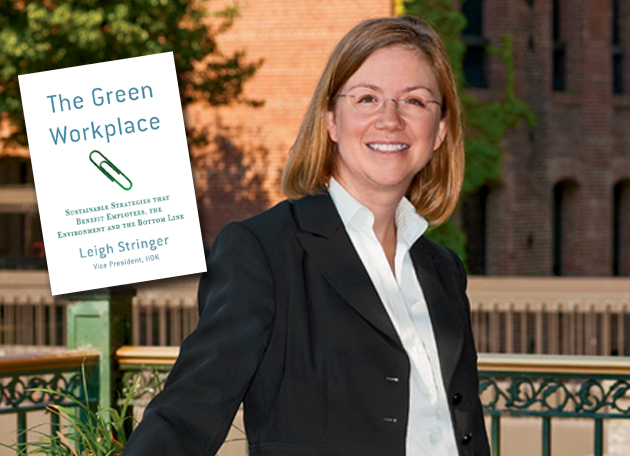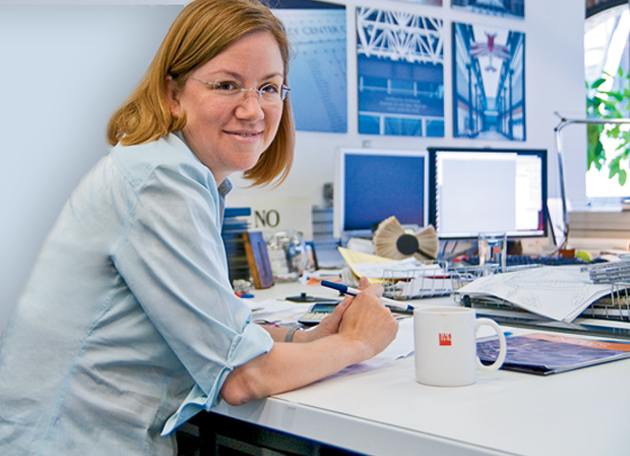
The people who devote themselves to sustainability issues have a story — something specific that changed how they see the world and made them want to do something about it,” says Leigh Stringer, AB ’93 (architecture), MArch ’98, MBA ’98.
Stringer, a senior vice president at Hellmuth, Obata & Kassabaum (HOK) and author of The Green Workplace, definitely falls into those categories: She is devoted to sustainability issues, and she has a story.
Stringer’s story began as nothing remarkable — just an evening out with her husband to see a movie she wasn’t very excited to see. It was 2006, and Al Gore’s film An Inconvenient Truth was playing in theaters. Stringer’s husband, a consultant who focuses on helping political and advocacy clients make an impact via the Internet, convinced her they should see the documentary.
“I was moved by the story and the science,” Stringer says. “It kicked off a spiral of heady research as I tried to figure out how I could make a difference in my field.”
The more she learned about sustainable architecture and practices, the more motivated she became.
“The sustainability issue has awoken us as architects,” she says. “We had been asleep for a while, making building after building using the same materials in the same ways. I’m inspired again by the challenge [of being green], and by the sense of meaning.”
Building on a strong foundation
As a teenager growing up in Birmingham, Ala., in the 1980s, Stringer didn’t know much about environmental issues. She was, however, drawn to architecture early on. With her artist mom and math-wiz dad, Stringer says she has a right-brain/left-brain balance that’s well-suited for the field. Washington University’s architecture school was a good fit “for a lot of reasons.”
“I loved everything about [architecture school],” Stringer says. “It’s very grounded in reality, and very focused on people and psychology — how people interact, and how the spaces they spend time in affect them.”
After graduating, Stringer worked for a small architecture firm in Memphis, where she helped design some “great projects” like schools and a children’s museum. During that time, Stringer also gained some new insight into herself.
“I realized, ‘I love design and want to be around design, but I’m really good at business. I can help architects do better business,’” she says.
Stringer then went back to Washington University to earn joint MArch and MBA degrees. The combination suited her perfectly, even though she was often “the only student wearing a suit in the architecture school, or the only one wearing artist black in the business school.” The two fields, she says, pair well in other ways.
“Business skills are very much about people and how they interact in various settings, which was what I always loved about architecture,” Stringer says.
After earning her graduate degrees, Stringer lived in Chicago, St. Louis and London, and she eventually landed at HOK, in Washington, D.C. Along the way, she developed a specialty in workplace issues and then a passion for sustainability. Before she knew it, Stringer was considered an expert in green workplaces, giving presentations on the topic and starting a blog (TheGreenWorkplace.com), which led to writing a book.
Helping companies, and individuals, go green
Published in 2009, The Green Workplace: Sustainable Strategies that Benefit Employees, the Environment and the Bottom Line (Palgrave Macmillan) shows companies how to lessen their impact on the environment. The book isn’t only for companies thinking about renovations or a new building, Stringer says, because a green workplace is not just about green architecture.
“The biggest myth out there is that we can fix the problem by fixing the building — just by using the right materials and energy systems, and then we’re done,” she says. “But people use buildings. The issue is very behavioral-based — so much so that we can make a difference by our actions alone, without necessarily investing a dollar in the building.”
“The biggest myth out there is that we can fix the problem by fixing the building — just by using the right materials and energy systems,” Stringer says. “But people use buildings. The issue is very behavioral-based — so much so that we can make a difference by our actions alone, without necessarily investing a dollar in the building.”
Commuting can be reduced, for example, when alternative work strategies are adopted, like working from home. Utilizing video-conferencing and other technology can cut down on business travel, and increasing access to existing natural light in workspaces can save energy.
In addition to impacting individual behavior, Stringer says adjusting and fine-tuning company policies, and better coordination between people and the systems put in place, can make a difference.
“It’s very much an evolving thing,” she says. “The hardest part for companies is to determine which decisions need to be made now, and which can come later. You have to take it one step at a time.”
Stringer organized and wrote her book to help companies take action without feeling overwhelmed. The book includes steps to take, points to the right internal people to engage, and gives examples through many case studies.
“Half of my job is as a motivational speaker,” Stringer says. “We need to make every argument for why people should move in this direction, not just one argument, because so many factors work against making smart choices.”
Stringer experiences this reality firsthand, as she tries to practice in her personal life what she preaches in her professional life. Making green choices, she has discovered, isn’t always second nature — even for her. Three years ago, Stringer, her husband and their young daughter were living in a small apartment in Georgetown, within walking distance of her HOK office. Feeling cramped, they began looking at houses. They even considered bidding on one that would have required a 40-minute commute to work each way, as well as yard care and other maintenance.
“We began to question our desire to run to the suburbs and, ultimately, decided less is more,” Stringer says. “The issue was about more than just being green, though — it was also about quality of life and cost of living. It took a well-rounded argument to convince myself, just as it takes a well-rounded argument to convince businesses, that this is the right thing to do.”
And the “right thing to do” takes time. While much progress has been made since Stringer first saw An Inconvenient Truth in 2006, she sees no shortage of work still to be done.
“It’s a very exciting time … but I still think we have far to go,” she says. “We’re talking another 10 to 20 years, a whole evolution, before we hit net zero. Therefore, I just try to look at what people are struggling with today. We’ll worry about tomorrow, tomorrow.”
When pushed to look ahead, however, Stringer does say she has a dream — one that’s unusual for an author.
“My dream is that in a year or two, my book will be completely obvious — old news. Wouldn’t that be great?”
Kristin Tennant is a freelance writer based in Urbana, Ill.

Comments and respectful dialogue are encouraged, but content will be moderated. Please, no personal attacks, obscenity or profanity, selling of commercial products, or endorsements of political candidates or positions. We reserve the right to remove any inappropriate comments. We also cannot address individual medical concerns or provide medical advice in this forum.